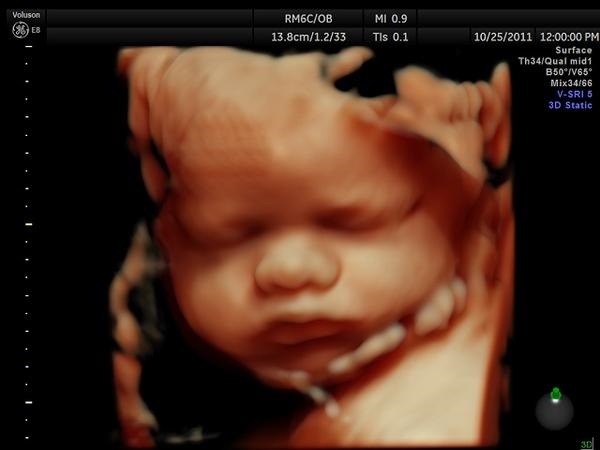A new Ohio law takes effect today that bans late-term abortions on unborn babies after 20 weeks. The law is designed to protect unborn children who research shows feel excruciating pain during abortion procedures.
In December, Governor John Kasich signed the Pain-Capable Unborn Child Protection Act (Sub. S.B. 127), landmark legislation which would ban late-term abortions after 20 weeks of pregnancy.
“I agree with Ohio Right to Life and other leading pro-life advocates that SB 127 (a 20-week ban) is the best, most legally sound and sustainable approach to protecting the sanctity of human life,” Kasich said in a statement.
Officials with Ohio Right to Life tell LifeNews they’re excited about the new pro-life law.
“Today, the Pain-Capable law takes effect in Ohio without one lawsuit from Planned Parenthood, the ACLU, or any of the other abortion facilities in the state,” says Devin Scribner, Executive Director of Ohio Right to Life. “Not only will our new law save hundreds of lives in our state, it is also part of a broader national strategy that will save thousands.”
“Sadly, the United States remains one of only 7 countries, including North Korea and China, where abortions are permitted after 20 weeks. Now, Ohio is one of 16 states that is leading our country out of the darkness, away from this archaic practice,” Scribner added. “The Pain-Capable Unborn Child Protection Act is a critical step in the national pro-life movement’s incremental effort to end abortion-on-demand. With this law, Ohio now stands outside of the archaic framework set up in Roe v. Wade, protecting unborn children just before the court-mandated 24 weeks.”
But more work remains.
SUPPORT LIFENEWS! If you like this pro-life article, please help LifeNews.com with a donation!
“Today, as our law takes effect, we are hard at work on the next set of laws that will scale back abortion-on-demand. At the top of the list is the Dismemberment Abortion Ban, legislation which would ban brutal dilation and evacuation abortions, nearly 3,000 of which occurred in Ohio in 2015,” he continued.
The pro-life laws are making a difference.
“Since 2010, abortions have dropped 25 percent—that amounts to 7,000 lives saved from abortion! In that same time, we have witnessed half of the state’s abortion facilities close or curtail their services,” Scribner noted. “Together with our statewide affiliates, life-affirming pregnancy centers, sidewalk counselors, and countless other pro-life activists and advocates in our state, we have ensured that life is winning in Ohio.”
At twenty weeks, the child has all the parts in place – the pain receptors, spinal cord, nerve tracts, and thalamus – needed for transmitting and feeling pain.
The unborn child responds to touch as early as week six, and by week eighteen, pain receptors have appeared throughout the child’s body.
“The thalamus which is the center of pain consciousness in the brain develops during weeks eight through sixteen, and the nerve tracts connecting the spinal cord and thalamus are themselves in place by week 20,” says Randy O’Bannon of National Right to Life. “Like infants, the unborn child cannot speak and describe his or her pain experience, but there are the usual physiological indicators that indicate pain awareness.”
“As early as eighteen weeks, an unborn child injected with a needle releases stress hormones, just as adults do when experiencing pain. Hormone levels in those babies decrease when pain-relievers are supplied,” he added. “Studies indicate that anencephalic infants, whose cortex is severely reduced if not altogether absent, experience pain as long as other neurological structures are functioning.”
Though abortion advocates deny the science of fetal pain, researchers have fully established fetal pain at 20 weeks or earlier. Dr. Steven Zielinski, an internal medicine physician from Oregon, is one of the leading researchers into it. He first published reports in the 1980s to validate research showing evidence for unborn pain.
He testified before U.S. Congress that an unborn child could feel pain at “eight-and-a-half weeks and possibly earlier” and that a baby before birth “under the right circumstances, is capable of crying.”
Dr. Colleen A. Malloy, a professor of neonatology at Northwestern University’s Feinberg School of Medicine, told a Senate committee last year that “anesthesiologists, and surgeons use pain medication” at the 20 week stage, “because it’s supported by the literature completely.”
“The standard of care for NICUs requires attention to and treatment of neonatal pain,” she said. “There is no reason to believe that a born infant will feel pain any differently than that same infant if he or she were still in utero.”
“I could never imagine subjecting my tiny patients to a horrific procedure such as those that involve limb detachment or cardiac injection,” Malloy added.
A national poll by The Polling Company found that, after being informed that there is scientific evidence that unborn children are capable of feeling pain at least by 20 weeks, 64% would support a law banning abortion after 20 weeks, unless the mother’s life was in danger. Only 30% said they would oppose such a law.








